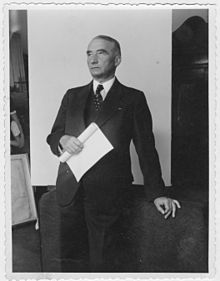Adolf Wissel
Adolf Wissel (born April 19, 1894 in Velber ; † November 17, 1973 ibid.) Was a German genre painter of peasant and rural subjects .
life and work
Born in 1894 as the son of a farmer in Velber at the time of the German Empire , Adolf Wissel first attended the Humboldt High School in Hanover until his secondary school leaving certificate , then from 1911 to 1914 the local arts and crafts school , mainly under Richard Schlösser , to whom Wissel remained lifelong.
After studying at the Kassel Art Academy in the early 1920s , he returned to his place of birth in Velber near Hanover in 1924 . There he gained first regional recognition before 1933. His works are designed in a style related to the New Objectivity . As a painter of the “Scholle”, ie the rural world, he achieved some successes during the National Socialist era . In particular, his picture Kalenberger Bauernfamilie , created in 1938/39, has been exhibited and reproduced many times.
Wissel's pictures have been exhibited several times in the Great German Art Exhibition in the House of German Art in Munich :
- 1938 the three oil paintings farmer's wife , portrait , crocheting peasant girl
- 1939 Kahlenberg farming family
- 1940 the four oil paintings of old farmer , portrait , landscape with cows , field work
- 1941 the four oil paintings haymaking , lady portrait , young girl , girl portrait
- 1942 the three oil paintings Dr. Crowd, former mayor of Hanover (loan from the city of Hanover), harvest , portrait
- 1943 the three oil paintings peasant girl , peasant woman , farmer
Honors

- 1939: Adolf Hitler awarded an honorary professorship
- The Adolf-Wissel-Straße in Velber honors the painter with its name
Works (excerpt)
- Self-portrait. 1930
- Sculptor August Waterbeck . 1932
- Portrait of Alexander Matting . undated
- Farmers group (1935)
- Hereditary farmer. undated
- Lady portrait. 1942
- Kalenberg peasant girl. 1943
- Portrait of the Prime Minister of Lower Saxony Heinrich Hellwege .
Exhibitions after 1945
- 1974 Memorial exhibition in the Historical Museum in Hanover
- 2012 Exhibition in the Heimatmuseum Seelze
Quotes
- Ingeborg Bloth critically shows how the picture “Kalenberg Peasant Family” was treated as secondary by Wissel in the National Socialist cultural policy and in the exhibition system, while in research on Nazi painting it was declared to be a “'prototype' of the ideologically conformist family image”.
- There is evidence that Adolf Wissel did not significantly change his style or choice of subjects in 1933. He can hardly be accused of adapting to the new National Socialist rulers. But like so many other Germans, he was a partner and also a beneficiary of National Socialism in Germany. Until his death in 1973 he saw himself as an apolitical painter who merely pursued his profession. Whether intentionally or not, whether consciously or unconsciously, he supported the National Socialist system together with the majority of Germans - with fatal consequences for Germany and Europe.
literature
- Helmut Plath , Ernst Lüddeckens: The painter Adolf Wissel 1894–1973. Memorial exhibition. Exhibition guide of the Historical Museum. Hanover 1974, DNB 750942142 .
- Ingeborg Bloth: Adolf Wissel. Painting and Art Politics in National Socialism . Berlin 1994, ISBN 3-7861-1740-3 .
- Irmela Wilckens, Claudia Rump: Time travel through the Hanover region. Wartberg Verlag, Gudensberg-Gleichen 2005, ISBN 3-8313-1517-5 , pp. 62–63.
- Hugo Thielen : WISSEL, Adolf. In: Dirk Böttcher , Klaus Mlynek, Waldemar R. Röhrbein, Hugo Thielen: Hannoversches Biographisches Lexikon . From the beginning to the present. Schlütersche, Hannover 2002, ISBN 3-87706-706-9 , p. 392. ( online via Google books )
- Hugo Thielen: Wissel, Adolf. In: Klaus Mlynek, Waldemar R. Röhrbein (eds.) U. a .: City Lexicon Hanover . From the beginning to the present. Schlütersche, Hannover 2009, ISBN 978-3-89993-662-9 , p. 681.
Web links
- Literature by and about Adolf Wissel in the catalog of the German National Library
- Kalenberg farming family
- Self-portrait
Individual evidence
- ↑ a b c Hugo Thielen: WISSEL ... (see literature)
- ↑ Compare the documentation at Commons (see under the section Weblinks )
- ↑ Tobias Ronge: The image of the ruler in painting and graphics of National Socialism: an investigation into the iconography of leaders and functionaries in the Third Reich (= Tom 89 z art history ). LIT Verlag Münster, Münster 2010, ISBN 978-3-643-10856-2 , p. 223 ( limited preview in Google Book search). About Matting: Michael Grüttner : Biographical Lexicon for National Socialist Science Policy , Heidelberg 2004, ISBN 3-935025-68-8 , p. 115.
- ↑ Nazi art: Stuff from the poison cabinet. In: Spiegel online. April 24, 2000.
- ↑ Andreas Zoller: The landscape painter Edmund Steppes (1873-1968) and his vision of a "German painting". Dissertation . Braunschweig 1999, DNB 958021457
- ^ Irmela Wilckens, Claudia Rump: Time travel through the Hanover region. Wartberg Verlag, Gudensberg-Gleichen 2005, p. 63.
| personal data | |
|---|---|
| SURNAME | Wissel, Adolf |
| BRIEF DESCRIPTION | German genre painter of peasant-rural subjects |
| DATE OF BIRTH | April 19, 1894 |
| PLACE OF BIRTH | Velber |
| DATE OF DEATH | 17th November 1973 |
| Place of death | Velber |
